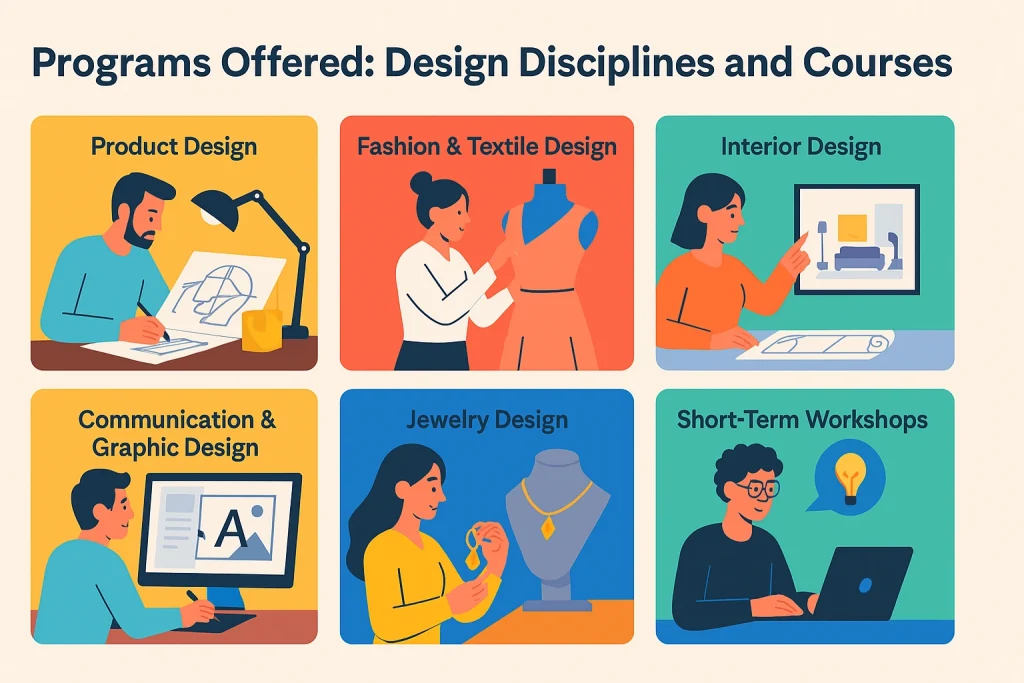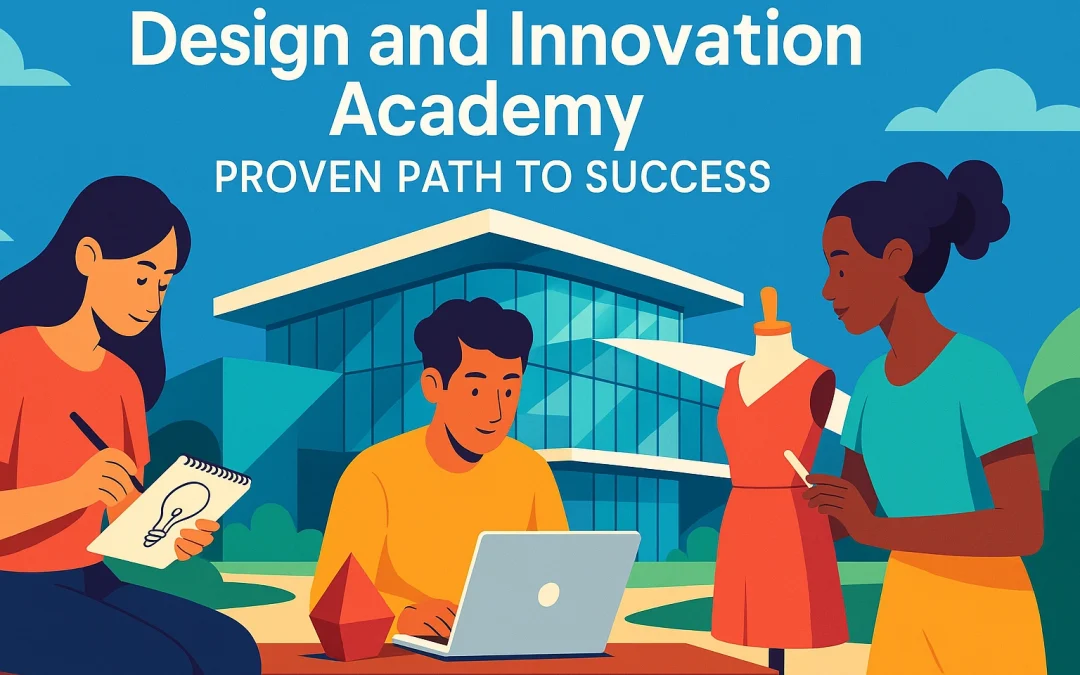Introduction
If you’re exploring creative education options, the idea of joining a design and innovation academy might feel both exciting and overwhelming. In today’s rapidly evolving creative landscape, these academies promise more than just design skills—they offer pathways to innovation, entrepreneurial thinking, and future-ready careers. Whether you’re curious about fashion, product design, textiles, or interior spaces, a design and innovation academy can be the launchpad that transforms your creative passion into a professional reality.
But not all academies are the same, and knowing which one aligns with your goals is essential. In this guide, I’ll walk you through everything you need to know — from course offerings and admission strategies to mentorship, portfolio preparation, and career outcomes. Let’s dive into what makes a design and innovation academy a powerful choice, and how you can make the most of it.
1. What Is a Design and Innovation Academy?

A design and innovation academy is a specialized educational institution focused on combining creative design training with innovation-driven thinking. These academies emphasize hands-on learning in design thinking, prototyping, user-centered design, and trend forecasting. Unlike traditional design schools, many innovation academies prioritize ideation, experimentation, and entrepreneurial thinking to prepare students to respond creatively to real-world design challenges.
For example, the IMS Design and Innovation Academy (IMS-DIA) in India was founded to address the gap between design education and industry needs, offering courses in fashion, textile, jewelry, product, and communication design. Their approach involves portfolio development, faculty feedback, and real-world workshops, giving students a chance to develop creative thinking and industry-ready design skills.
These academies often include entrance exams or portfolio reviews, and some offer short-term workshops, online certifications, or mentorship tracks to cater to both beginners and professionals.
By focusing on innovation and creative practice, the best design and innovation academies aim to build more than technical skill — they cultivate a mindset that helps graduates adapt, prototype, and launch creative solutions in changing markets.
2. Why Choose a Design and Innovation Academy?

2.1 Hands-On Creative Learning
One of the biggest advantages of a design and innovation academy is hands-on, creative learning. Rather than relying on lectures and theory, these programs emphasize real design projects, prototyping, and creative experimentation. Students learn by doing — whether it’s sketching, fabric draping, user interface prototyping, or product modeling. This practical focus helps to build creative confidence, refine design thinking, and foster an innovation mindset.
2.2 Industry Alignment and Portfolio Building
Innovative academies often design their curriculum around industry needs, making sure students graduate with both practical design knowledge and a portfolio that showcases real-world work. At IMS-DIA, for instance, applicants are evaluated through drawing/rendering tasks and a portfolio presentation, which are key parts of the admission process. The portfolio-focused approach ensures that students not only learn design theory but also build a strong creative portfolio that helps them launch careers in competitive fields like fashion, product design, and digital design.
2.3 Mentorship, Workshops, and Real-World Exposure
Design and innovation academies often embed mentorship and workshop structures into their programs. This means students receive direct feedback from faculty or industry experts, engage in design thinking workshops, and sometimes even collaborate with real clients or projects. Such exposure helps students to refine their design ideas, understand market trends, and learn iterative design and innovation processes — all of which are critical for success in creative careers.
2.4 Flexible and Diverse Program Options
Another strength is program flexibility. Many academies offer a range of options— from short-term workshops and certificate courses to full-time diploma or degree programs. Some provide online or hybrid certification routes, which can be especially useful for working professionals or international learners. Having multiple program tracks helps learners at different stages — beginners building foundational skills, professionals upskilling, or creatives switching careers.
3. Programs Offered: Design Disciplines and Courses

Design and innovation academies typically cover a spectrum of creative disciplines. Below is a breakdown of common program types and what they usually include.
| Discipline / Course Type | Typical Curriculum Elements | Typical Student Outcomes |
|---|---|---|
| Product Design | Ideation, sketching, prototyping, materials, user testing, packaging | Ability to design tangible products, prototypes, and consumer goods |
| Fashion & Textile Design | Fabric science, garment construction, draping, trend forecasting, portfolio creation | Skills in creating fashion collections, textiles, and styling |
| Interior & Spatial/Environmental Design | Space planning, rendering, materials, lighting, user experience | Capacity to plan and visualize interior spaces, installations, or exhibitions |
| Communication & Graphic Design | Visual design, branding, typography, digital media, UI/UX | Competence in creating digital visuals, brand stories, and interfaces |
| Jewelry & Luxury Product Design | Jewelry making techniques, design sketching, finishing, creative marketing | Competency in designing jewelry/luxury goods and building a creative brand |
| Short-Term & Online Workshops | Design thinking, rapid prototyping, portfolio creation, digital tools | Learners gain focused skills or certification in specific areas like UX or design thinking |
By understanding which disciplines each academy offers, students can better match their personal interests, career goals, and the practical skills they want to acquire.
4. How to Join: Admissions, Portfolio & Certification
Joining a design and innovation academy typically involves several steps—some of which are quite different from general academic admissions. Here’s a breakdown of what you can expect and how to prepare.
4.1 Admission Process Explained
-
Application Submission: Most academies require an online or in-person application form, academic transcripts, and sometimes a statement of intent or creative statement explaining why the applicant wishes to study design and innovation.
-
Entrance Exam or Design Test: Many programs administer a design aptitude test or drawing/rendering exercise. For instance, IMS-DIA uses an exam to evaluate observational skills, innovation, and drawing/rendering abilities, followed by portfolio submission.
-
Portfolio Review: A creative portfolio is often a vital component — it may include sketches, design projects, photographs, or other creative work. Some academies require applicants to present and discuss their work in an interview or evaluation session.
-
Interview or Jury Panel: In some cases, candidates are interviewed by faculty or a jury who review their creative approach, critical thinking, and passion for design. IMS-DIA’s final round includes a jury panel presentation.
4.2 Building a Strong Portfolio
A strong portfolio can make or break a candidate’s admission. A well-crafted portfolio should:
-
Showcase creative thinking and design process (not just final work).
-
Include varied project types — such as sketches, prototypes, concept boards, or completed design pieces.
-
Reflect critical thinking and evolution — showing how ideas developed over time.
-
Be presented clearly and professionally, with notes or captions explaining each piece.
-
Highlight any innovation or user-focused design approach.
-
If possible, include feedback or revisions—to show that the creator can iterate and refine ideas.
4.3 Certification and Online Options
Not all learners wish or are able to commit to full-time study. To accommodate different needs, many design and innovation academies offer:
-
Short-term certificate courses focused on design thinking, UX, or prototyping.
-
Online or hybrid programs that offer flexibility to working professionals or international learners.
-
Workshop-based sessions that allow learners to focus intensively on one skill area (e.g. fashion draping, digital sketching, design thinking sprints).
-
Some academies provide certification upon completion, which can be valuable for portfolios or resumes — especially for freelancers or those switching careers.
Online certification options can make design education more accessible, though they may not offer the same hands-on studio experience as in-person programs.
5. Skill Development: Design Thinking, Prototyping & Innovation Mindset
One of the defining features of a design and innovation academy is its focus on skill-based training. These programs are designed not just to teach design, but to develop an innovation mindset—enabling students to think flexibly, solve problems, and prototype new ideas. Below are core skill areas emphasized in many academies:
5.1 Creative Thinking & Ideation Techniques
-
Brainstorming and ideation methods: Students learn structured techniques for generating ideas, exploring multiple design directions, and pushing creativity beyond obvious concepts.
-
Mind mapping and sketching exercises: Visual tools such as sketchbooks and storyboards help learners translate abstract ideas into concrete design directions.
-
Trend research and creative inspiration: Students are taught how to research design trends, user behavior, and market insights to inform their design work.
-
Feedback and iteration: Learning to accept critique, iterate designs, and evolve creative ideas is central to building strong design thinking.
These creative thinking workshops help foster an innovation mindset, ensuring that designers don’t just follow trends, but actively question and shape design futures.
5.2 Prototyping, User-Centered Design & Testing
-
Prototype creation: Students build tangible or digital prototypes—such as models, mockups, or interactive interfaces—to test design ideas early.
-
User testing and feedback loops: By testing prototypes with users or peers, students learn how to gather insights, pivot ideas, and refine design concepts.
-
Iterative design cycles: Design iteration—from early concept to refined prototype—is emphasized. Students learn that failure and refinement are essential parts of innovation.
-
Materials and fabrication: Depending on the discipline, learners may explore materials, fabrication techniques, or digital tools to realize their prototypes, thus deepening their understanding of how designs function in real-world settings.
These skills are critical for any designer who wants to move from idea to execution, ensuring that work is both creative and user-focused.
5.3 Innovation Mindset & Trend Forecasting
-
Futures thinking: Academies encourage students to think beyond current design norms, imagining future user needs, sustainable design solutions, and speculative product ideas.
-
Trend forecasting: Understanding how market shifts, technology, user behavior, and culture influence design trends helps students create forward-thinking work.
-
Sustainability and ethical design: Many programs also incorporate lessons on sustainable design practices, ethical considerations, and social impact, which are increasingly important in creative industries.
-
Entrepreneurial thinking: Designers are taught how to view their work as potential products or services—thinking about business models, marketing, and innovation strategy.
By combining practical prototyping with futures-oriented thinking and ethical awareness, students can graduate with both creative confidence and strategic insight into how to shape design in meaningful ways.
6. Mentorship, Workshops & Faculty Support
A standout feature of many design and innovation academies is the mentorship and workshop structure embedded in the curriculum. This support helps bridge the gap between theoretical learning and professional practice.
-
Faculty Mentorship: Experienced designers, industry professionals, and educators often guide students through personalized review sessions. This feedback loop helps learners refine their design direction, polish their creative work, and develop critical thinking.
-
Design Workshops and Sprints: Hands-on workshops allow students to engage in concentrated design thinking sessions—where they ideate, prototype, test, and iterate in collaborative settings.
-
Real-World Projects and Client Exposure: Some academies partner with industry, NGOs, or real clients to give students exposure to live design briefs, client feedback, and project-based learning—helping them simulate real design processes.
-
Portfolio Reviews and Showcase Events: Regular portfolio review sessions and final showcases give students a chance to present their work, receive critique, and network with peers, faculty, and potential clients or employers.
These mentorship and workshop structures are vital. They not only help students improve design skills but also build the confidence and adaptability required to succeed in creative professions.
7. Career Paths & Outcomes for Graduates
Completing a design and innovation academy can open multiple creative and professional pathways. The skills acquired are versatile and can be applied in many fields, depending on individual interests and strengths.
7.1 Internships and Industry Collaboration
Most design academies encourage or facilitate internships, giving students real-world exposure in creative studios, fashion houses, design firms, or product development teams. Working on live projects allows students to build experience, professional contacts, and refine their portfolios. Some academies even collaborate with industry partners to offer mentorship or placement opportunities.
7.2 Portfolio Showcases and Job Placements
A thoughtfully built portfolio is often the key to landing interviews, freelance opportunities, or job placements. Graduates might find roles such as:
-
Product designer or industrial designer
-
Fashion designer or textile designer
-
Interior designer or exhibition designer
-
User interface or experience designer
-
Creative consultant or design strategist
-
Freelance designer or creative entrepreneur
Showcasing work through exhibitions, digital portfolios, or social media can attract hiring managers or clients, especially when portfolios reflect process, creativity, and innovation.
7.3 Entrepreneurship and Freelance Design Careers
Some graduates take their academy experience further by starting their own creative ventures—launching design studios, fashion lines, product startups, or freelance services. The innovation mindset, combined with prototyping and trend-led thinking, equips these creative professionals to launch original products or services. For many, the skills gained in design thinking or innovation workshops become the foundation for entrepreneurial success or freelance careers.
8. Comparison: Design & Innovation Academy vs Traditional Design School
Choosing between a design and innovation academy and a traditional design school depends on your learning style, career goals, and desired educational experience. Here’s a side-by-side comparison to help you decide.
| Feature | Design & Innovation Academy | Traditional Design School |
|---|---|---|
| Learning Style | Hands-on, project-based, innovation-focused | Lecture-based, theory + studio work |
| Portfolio Emphasis | High; portfolio review is crucial | Important, but often secondary to coursework |
| Mentorship & Industry Feedback | Intensive mentorship, workshops, client briefs | Faculty-led critique, less real client exposure |
| Flexibility | Offers short-term, online, and hybrid course options | Mostly full-time degree programs |
| Innovation Focus | Strong—emphasis on emerging trends, ideation, futures | More emphasis on foundational techniques and history |
| Certification | Certificates, workshops, diplomas | Degrees (Bachelor’s, Master’s) |
| Career Preparation | Geared toward creative entrepreneurship, freelancing, and real-world projects | Structured academic path, some internships |
In summary, design and innovation academies tend to be more agile, industry-aligned, and focused on innovation and portfolio-building. Traditional design schools often offer a deeper theoretical foundation and structured degrees. Your choice should depend on whether you prefer creative experimentation and real-world practice or a more formal academic route.
9. Financial Considerations: Costs, Scholarships & Return on Investment
Entering a creative education program is an investment—not just in time, but in money, effort, and opportunity. Here’s what to consider when evaluating design and innovation academies.
-
Tuition and Fees: Costs vary widely depending on program type (full-time diploma vs short workshop vs online certification) and location. Some academies include materials and production costs, while others may charge extra for studio access.
-
Scholarships and Financial Aid: Many design academies offer scholarships, grants, or fee waivers to talented or underprivileged students. At IMS-DIA, for example, scholarship opportunities are mentioned as part of their admission structure.
-
Value for Money: Consider the return on investment (ROI): How likely are you to land a job, freelance opportunity, or design project that generates income from your portfolio or academy training? Does the academy provide career placement, mentorship, or connections?
-
Opportunity Cost: Time spent studying is time not earning. If you take a full-time program, evaluate whether the creative training and networking will be worth the temporary pause in professional work or earnings.
-
Supplemental Costs: Don’t forget supplemental costs like materials, software subscriptions, travel for portfolio reviews or shows, and possibly living expenses, especially for on-site workshops or residencies.
Balancing these costs against potential creative and career benefits can help prospective students make informed decisions about whether a design and innovation academy is the right investment.
10. Real Student Stories and Success Examples
Hearing from former students can be one of the most insightful ways to understand the impact of a design and innovation academy. While specific alumni stories vary, here are some hypothetical (but realistic) profiles you might encounter:
-
Maya, Fashion Designer (IMS-DIA Graduate) – Built a portfolio of upcycled fashion and wearable art during her training. Her final showcase led to a collaboration with a boutique sustainable fashion brand, and she now works as a freelance fashion stylist and designer.
-
Rahul, Product Designer – Focused on user-centred design and prototyping during his academy workshops. After completing a product innovation course, he developed a line of ergonomic consumer gadgets and pitched them successfully at a local startup fair.
-
Leena, Visual Designer – Used the academy’s mentorship sessions to develop a digital branding project for a small business. Her final portfolio won a small grant, helping fund her freelance branding studio.
-
Arif, Creative Entrepreneur – Took an online certification in design thinking, then used the skills learned to launch a local creative consultancy. His focus on community-based design thinking has led to partnerships with NGOs and social enterprises.
These stories illustrate how design and innovation academy training can translate into real creative work, career advancement, or entrepreneurial success—especially when programs emphasize innovation, mentorship, and portfolio development.
Conclusion: Is a Design and Innovation Academy Right for You?
Choosing to attend a design and innovation academy is more than a learning decision—it’s a strategic step toward shaping your creative career and innovation mindset. If you’re someone who thrives in hands-on learning, enjoys creative experimentation, and wants to build a portfolio that reflects your process and creativity, then a design and innovation academy can offer significant value.
However, it’s essential to weigh the investment—time, cost, and effort—against your personal goals, and to pick a program that matches your desired design domain, learning style, and professional aspirations. Look for academies that offer strong portfolio training, mentorship, real-world projects, and flexible learning options.
Ultimately, whether you’re aiming to launch a fashion line, prototype innovative products, or build a freelance design studio, a design and innovation academy can be a powerful springboard—if you choose the right program and commit to your creative growth. With the right preparation, portfolio, and mindset, you can transform your creative passion into a meaningful, career-driving practice.
FAQ: Key Questions About Design and Innovation Academy
Q1: What is the difference between a design academy and a design and innovation academy?
A design academy typically focuses on teaching traditional design skills—such as sketching, illustration, or fashion techniques. A design and innovation academy adds an extra layer by teaching design thinking, ideation, prototyping, trend forecasting, and innovation mindset, preparing you to think critically and creatively in evolving markets.
Q2: How important is a portfolio when applying to a design and innovation academy?
A creative portfolio is usually one of the most critical parts of your application. It shows your process, ideas, revisions, and final work. Academies often interview applicants based on their portfolios and evaluate their ability to iterate and solve design challenges.
Q3: Can I complete design and innovation academy training online?
Yes—many academies now offer online or hybrid certification programs, workshops, or short courses, which are ideal for international learners or creative professionals. However, online programs may offer less hands-on studio experience compared to on-site training.
Q4: Will a design and innovation academy improve my job prospects?
A focused design and innovation program can significantly improve your creative thinking, portfolio strength, and professional readiness—especially if it includes mentorship, real-world projects, and strong portfolio training. Some graduates go on to careers in product design, fashion, freelancing, or creative entrepreneurship.
Q5: How much does it cost to attend a design and innovation academy?
Costs vary widely—from short workshops costing a few hundred dollars to full-time programs that can be much more expensive, depending on location, duration, and materials. Many academies offer scholarships or financial aid, so it’s important to check each program’s offerings carefully.
For a deeper dive into design thinking methodologies and how they shape innovation education, check out IDEO’s Design Thinking resources here: IDEO – What is Design Thinking?
More Info: confidence it

